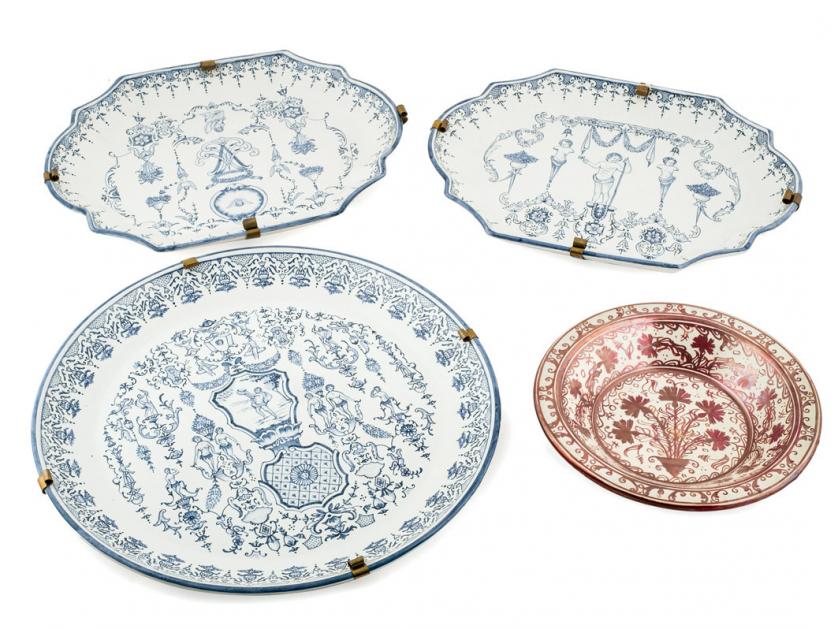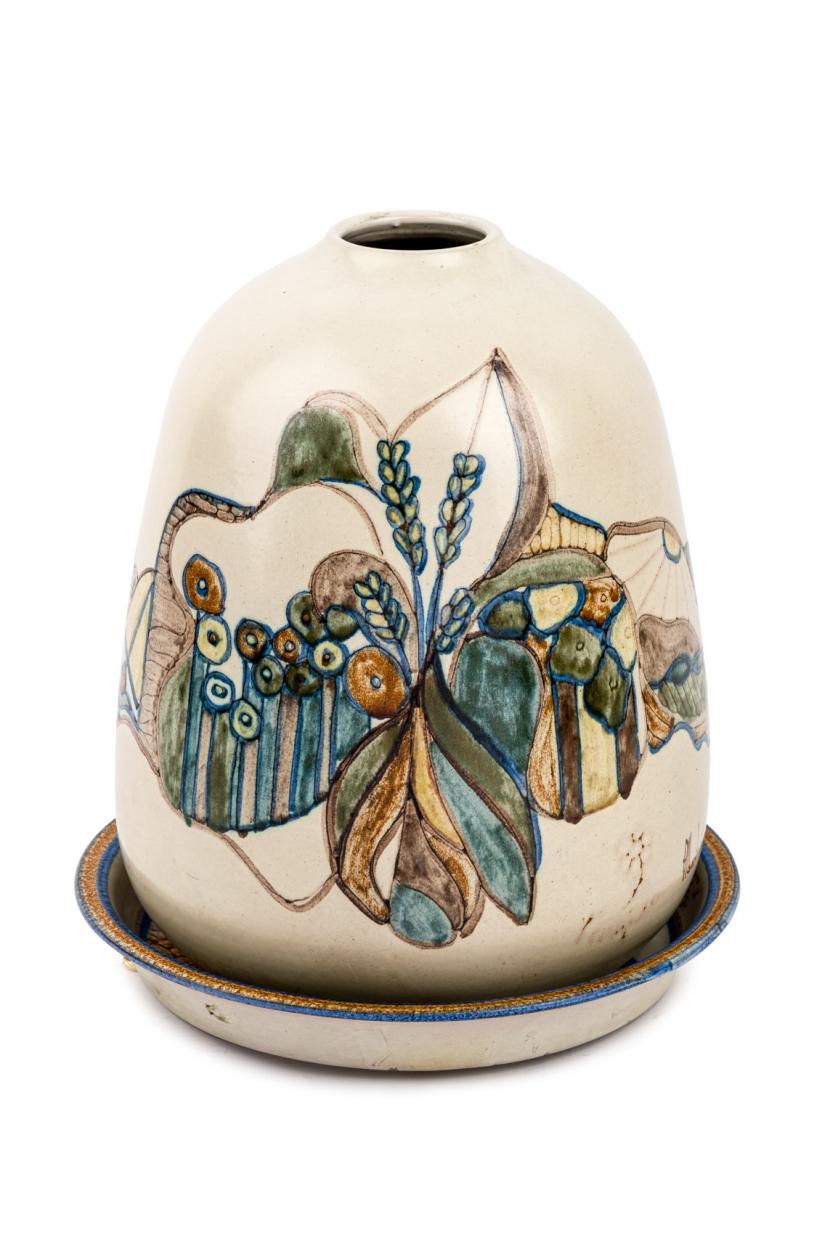Timaeus [AND] Critias [from Ficini's 1484 Opera]. Translated into Latin by Marsilius Ficinus, together with commentary. [Florence: Laurentius (Francisci) de Alopa, Venetus, for Francesco Berlinghieri and Philippus Valor, 1484]. FIRST EDITION OF PLATO'S TIMAEUS. Folio (185 x 212 mm). 42 CONSECUTIVE LEAVES, comprising the complete parts III & IV from the First Printing of Plato's Opera, as printed in discrete parts at San Jacopo de Ripoli (see Kristeller), Collation: et8 cō4 rū6 [et]10 [con]8 [rum]6. 46 lines and headlines, two printed and two manuscript diagrams, double column, initial spaces, neatly bound in stiff modern wrappers. SAVING THE PHENOMENA, THE FIRST SCIENTIFIC COSMOLOGY, containing the first recorded scientific application of mathematics to the explanation of nature. Conceiving the cosmos to be a beautifully ordered mechanism operating according to natural law, the Timaeus is the first great statement of science. In positing geometry to be the ultimate explanatory instrument of natural order, Plato here effectively invents mathematical physics, and originates the challenge to early scientists to "save the phenomena." Written almost 2500 years ago, the Timaeus provides the first explicit statement of the principle of physical causality: "all that becomes must needs become by the agency of some cause; for without a cause nothing can come to be" (Timaeus, 28a, 28c). Drawing on the mathematical perspective of the Pythagoreans for the purpose of theoretically explaining the empirical world, Plato here brilliantly "saves the phenomena" of the seemingly irregular motions of the heavens and the apparently erratic flux of the elements. In addition to these two grand themes, the Timaeus also pursues specific scientific inquiries ranging from geophysics, metallurgy, and hydraulics to botany, physiology, and pathology. More than in any other dialogue, the Timaeus evidences Plato the scientist and mathematician vigorously at work -- positing that counter-revolving circles drive the motions of the heavens; that elemental transmutation is the work of a geometric atomism (involving the decomposition and recomposition of the surfaces of the five Platonic solids); and that the soul of the universe is to be considered a harmonic composition of natural process. The Timaeus integrally links mechanics and technicality with the thinking of science, and with the Timaeus one begins to perceive nature assuming the algorithmic regularity of a clockwork universe. In the Critias, the companion dialogue, Critias relates the story of Atlantis first synoptically transmitted in the Timaeus, now elaborated in its entirety for the first time. Atlantis, a fabulously rich culture, technologically advanced and populous, loses connection with virtue and divinity, filled with a lust for possessions and power. Seeking to enslave all of the Mediterranean as far as Egypt, they are stopped by the virtuous Athenians. A cautionary myth, Critias is also an allegorical rendering of the physical principles articulated in the Timaeus. According to Paul Oskar Kristeller, Ficini's Opera of Plato was printed in parts beginning in February 1484 and finishing before September 1484 at the press of San Jacopo de Ripoli, significantly the first press known to employ women. The Timaeus and Critias were printed together as Part IV of Plato's Opera; and Ficino's own original statement on the Timaeus, Compendium in Timaeum as Part III. One can speculate that the discretely printed parts of the 1484 Opera may have been sold individually or collectively, as with Aldus's Aristotle of 1495-8, which might explain the high percentage of surviving copies which are defective. The Timaeus is central to Plato's work and brings his philosophy into concrete focus: "the one place in Plato's work where all of the 'furniture' of Platonism – gods, souls, Ideas, space, properties, natural and artificial kinds – are seen related each to all within a single frame." (Mohr, pp xix-xx). The relat
Timaeus [AND] Critias [from Ficini's 1484 Opera]. Translated into Latin by Marsilius Ficinus, together with commentary. [Florence: Laurentius (Francisci) de Alopa, Venetus, for Francesco Berlinghieri and Philippus Valor, 1484]. FIRST EDITION OF PLATO'S TIMAEUS. Folio (185 x 212 mm). 42 CONSECUTIVE LEAVES, comprising the complete parts III & IV from the First Printing of Plato's Opera, as printed in discrete parts at San Jacopo de Ripoli (see Kristeller), Collation: et8 cō4 rū6 [et]10 [con]8 [rum]6. 46 lines and headlines, two printed and two manuscript diagrams, double column, initial spaces, neatly bound in stiff modern wrappers. SAVING THE PHENOMENA, THE FIRST SCIENTIFIC COSMOLOGY, containing the first recorded scientific application of mathematics to the explanation of nature. Conceiving the cosmos to be a beautifully ordered mechanism operating according to natural law, the Timaeus is the first great statement of science. In positing geometry to be the ultimate explanatory instrument of natural order, Plato here effectively invents mathematical physics, and originates the challenge to early scientists to "save the phenomena." Written almost 2500 years ago, the Timaeus provides the first explicit statement of the principle of physical causality: "all that becomes must needs become by the agency of some cause; for without a cause nothing can come to be" (Timaeus, 28a, 28c). Drawing on the mathematical perspective of the Pythagoreans for the purpose of theoretically explaining the empirical world, Plato here brilliantly "saves the phenomena" of the seemingly irregular motions of the heavens and the apparently erratic flux of the elements. In addition to these two grand themes, the Timaeus also pursues specific scientific inquiries ranging from geophysics, metallurgy, and hydraulics to botany, physiology, and pathology. More than in any other dialogue, the Timaeus evidences Plato the scientist and mathematician vigorously at work -- positing that counter-revolving circles drive the motions of the heavens; that elemental transmutation is the work of a geometric atomism (involving the decomposition and recomposition of the surfaces of the five Platonic solids); and that the soul of the universe is to be considered a harmonic composition of natural process. The Timaeus integrally links mechanics and technicality with the thinking of science, and with the Timaeus one begins to perceive nature assuming the algorithmic regularity of a clockwork universe. In the Critias, the companion dialogue, Critias relates the story of Atlantis first synoptically transmitted in the Timaeus, now elaborated in its entirety for the first time. Atlantis, a fabulously rich culture, technologically advanced and populous, loses connection with virtue and divinity, filled with a lust for possessions and power. Seeking to enslave all of the Mediterranean as far as Egypt, they are stopped by the virtuous Athenians. A cautionary myth, Critias is also an allegorical rendering of the physical principles articulated in the Timaeus. According to Paul Oskar Kristeller, Ficini's Opera of Plato was printed in parts beginning in February 1484 and finishing before September 1484 at the press of San Jacopo de Ripoli, significantly the first press known to employ women. The Timaeus and Critias were printed together as Part IV of Plato's Opera; and Ficino's own original statement on the Timaeus, Compendium in Timaeum as Part III. One can speculate that the discretely printed parts of the 1484 Opera may have been sold individually or collectively, as with Aldus's Aristotle of 1495-8, which might explain the high percentage of surviving copies which are defective. The Timaeus is central to Plato's work and brings his philosophy into concrete focus: "the one place in Plato's work where all of the 'furniture' of Platonism – gods, souls, Ideas, space, properties, natural and artificial kinds – are seen related each to all within a single frame." (Mohr, pp xix-xx). The relat
.jpg)














Try LotSearch and its premium features for 7 days - without any costs!
Be notified automatically about new items in upcoming auctions.
Create an alert